- Jantar mantar at a glance
- History of Jantar Mantar Observatory
- Things to see at Jantar Mantar, Jaipur
- Laghu Samrat Yantra
- Dhruv Darshak Pattika
- Vrihat Samrat Yantra
- Rashi Valaya Yantra
- Disha Yantra
- Kanali Yantra
- Narivalaya Yantra – Equatorial Instrument
- Shastansh Yantra
- Palbha Yantra
- Misra Yantra
- Yantra Raj Yantra
- Krantivritta Yantra
- Chakra Yantra
- Rama Yantra
- Unnatansha Yantra
- Dakshinottara Bhitti Yantra
- Digamsha Yantra
- Kapali Yantra
- Jai Prakash Yantra
- Jantar Mantar, Jaipur: Timings and Location
- Jantar Mantar Sound & Light Show
- In conclusion
Jantar mantar at a glance
The name Jantar Mantar is derived from the words Yantra and Mantra, where Yantra means instrument and Mantra means formula. This name is apt as the whole complex is a giant open air observatory, aimed at studying the cosmos. It was recognised as a UNESCO World Heritage Site in the year 2010.

The observatory has many statistical instruments for measuring time, predicting eclipses and to ascertain other astronomical events.
In total there were 5 such observatories built by the same ruler between 1724 and 1740, out of which the one in Jaipur is the largest and most elaborate.
Entry fee of Jantar Mantar, Jaipur
- Indian National: Rs 50
- Foreign Nationals: Rs. 200
- Indian Students: Rs. 15
- Foreign Students: Rs. 100.
- Extra charges need to be paid for still and video camera, however mobile photography is allowed.
How to Reach:
Jantar Mantar is accessible by taxi, bus or even a cycle-rickshaw from different parts of the city. Cabs and taxis can be booked in advance or can be hired from the hotels that you are staying at. Rickshaws are the traditional means of transport in Jaipur and you can fascinate yourself by riding in this cycle-rickshaws from most parts of the city.
Jaipur is accessible by road, air and rail from almost every corner of the country. The fares may differ based on the season you are travelling in and the mode of transportation.
Timing of Jantar Mantar, Jaipur
Open on all days 9 AM to 5 PM.
Places to eat near Jantar Mantar, Jaipur
- Rawat Misthan Bhandar (300 Mtr)
- Midtown Multicuisine Restaurant (500 Mtr)
- Govindam Retreat (500 Mtr)
- Tattoo Café and Lounge (300 Mtr)
- Wind View Café (300 Mtr)
History of Jantar Mantar Observatory
The cosmic elements of Universe has fascinated the astronomers of India since long. Sawai Jai Singh II, the 17th century ruler of Jaipur, had keen interest in understanding of the planetary objects and their movements. He studied numerous books and sent scholars to several foreign countries like Greece, Britain, Arabia and Portugal to study the science of astronomy.
He built his first experimental observatory in Delhi by the name of Jantar Mantar. Later on, with the help of scholars like Pt. Jagannath Samrat and Pt. Keval Ramji, he built four more observatories, in Jaipur, Ujjain, Varanasi and Mathura.
After the passing of Sawai Jai Singh II, the observatories laid in disarray for most part of the 18th century. During the revolt of 1857, the observatory in Mathura was completely destroyed. In 1901, under Sawai Madho Singh II, Jantar Mantar was revived and restored to its former glory.
Things to see at Jantar Mantar, Jaipur
Jantar Mantar is a vast area consisting of some big instruments made primarily of stone and metals. To an untrained eye it would appear as some random shapes sprinkled in a park, completely oblivious to what these structures are capable of.
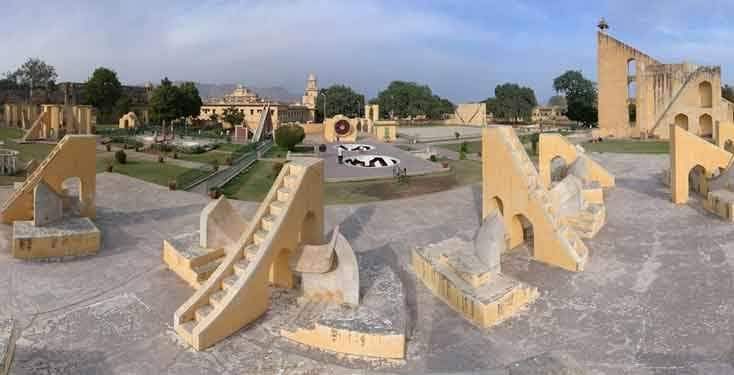
Laghu Samrat Yantra
The very first instrument one comes across as soon as they set foot here is a sun dial made of red sand stone and marble. It is triangular in shape and measures the time of the day. It is accurate up to 20 seconds and gives out Jaipur’s local time.
In India for simplicity, Indian standard time is followed throughout the country, but it is worth noting that for a country of this size, one time is not always accurate. For example, IST is marked with respect to the local time of Prayagraj, and Jaipur is pretty far from it in the west. Which basically means there will be some difference between IST and Jaipur’s local time. This difference can range from 10 mins to 40 mins depending on the season.


Hence the reading on the sundial will be off with respect to IST, by some minutes. In order to help the tourists confirm on the actual time, the administration has installed a small signage that specifies how many minutes needs to be added to the reading in order to get the accurate IST time. This signage is updated based on the season.
The sundial is big, almost 15 ft in height, still it’s called Laghu (which in Hindi means smaller). It is so, because it is dwarfed by the presence of another sundial a few meters ahead. But before that we have to check out the Dhruv Darshak Pattika.
Dhruv Darshak Pattika

The instrument is called Dhruvadarshak Pattika, meaning the pole star finder, and is in fact one of the simplest of instruments in the whole complex.
Next to Laghu Samrat Yantra this trapezoidal structure inclined at 27 degrees and made of red sandstone. The upper surface points towards the pole star on a clear dark night, hence it’s named after the pole star, known in Hindi as Druv Tara.
Vrihat Samrat Yantra
10 times bigger than the Laghu Samrat Yantra, the Vrihat Samrat Yantra is the largest sun dial in the world. The time displayed, is always within 2 seconds of modern clocks, the principle is same, it’s the accuracy and the size that makes it an improvement over the Laghu Samrat Yantra.
Apart from showing time, this instrument was used by astronomers on full moon days of June and July to study the movement and direction of the wind, which helps them forecast the monsoon. This is truly an engineering marvel of the 17th century which is relevant even today.

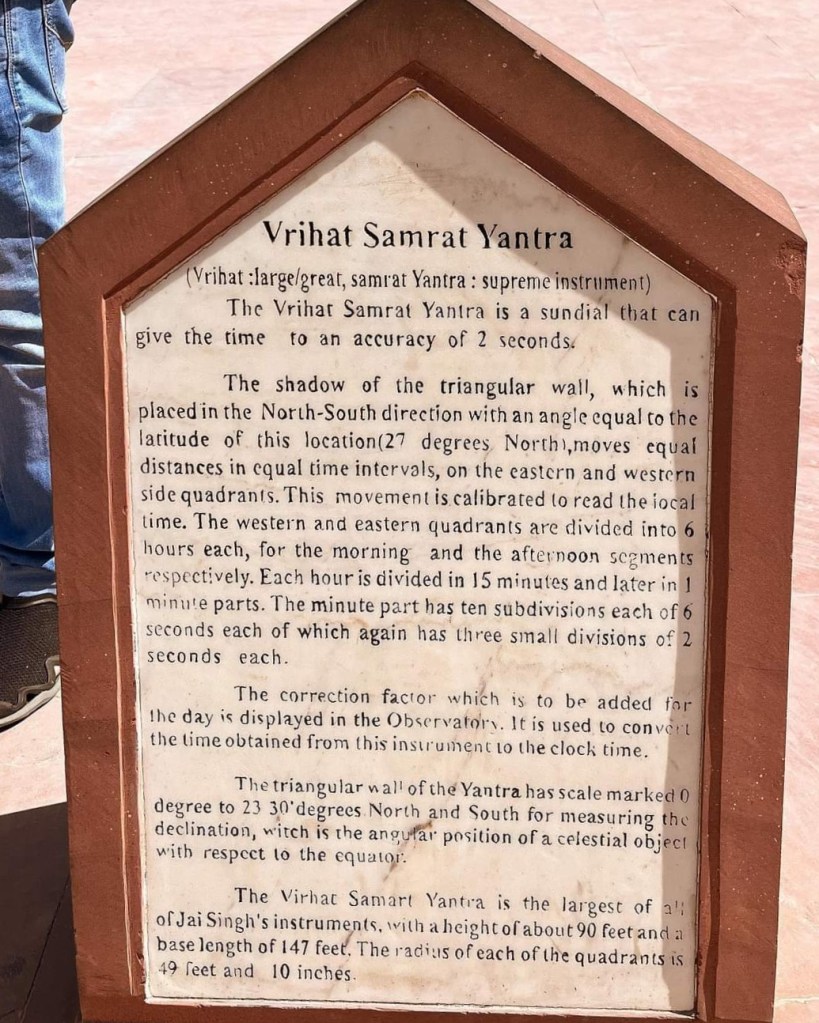
Rashi Valaya Yantra
It is a set of 12 instruments depicting the 12 zodiac (rashi) signs. All of them are located on a rectangular platform near southern wall of the observatory. It is an astrological instrument.
The royal astrologers would visit the zodiac instrument for a specific month, and study the sun’s rays on the instrument. The study was done to make their observations about the angles of the zodiac constellations of stars and chart out a horoscope.

Disha Yantra
To showcase the directions and measures the angle of the sun with respect to true north. This helped determine the hemispherical position of the sun, i.e whether the sun is in northern or southern hemisphere.
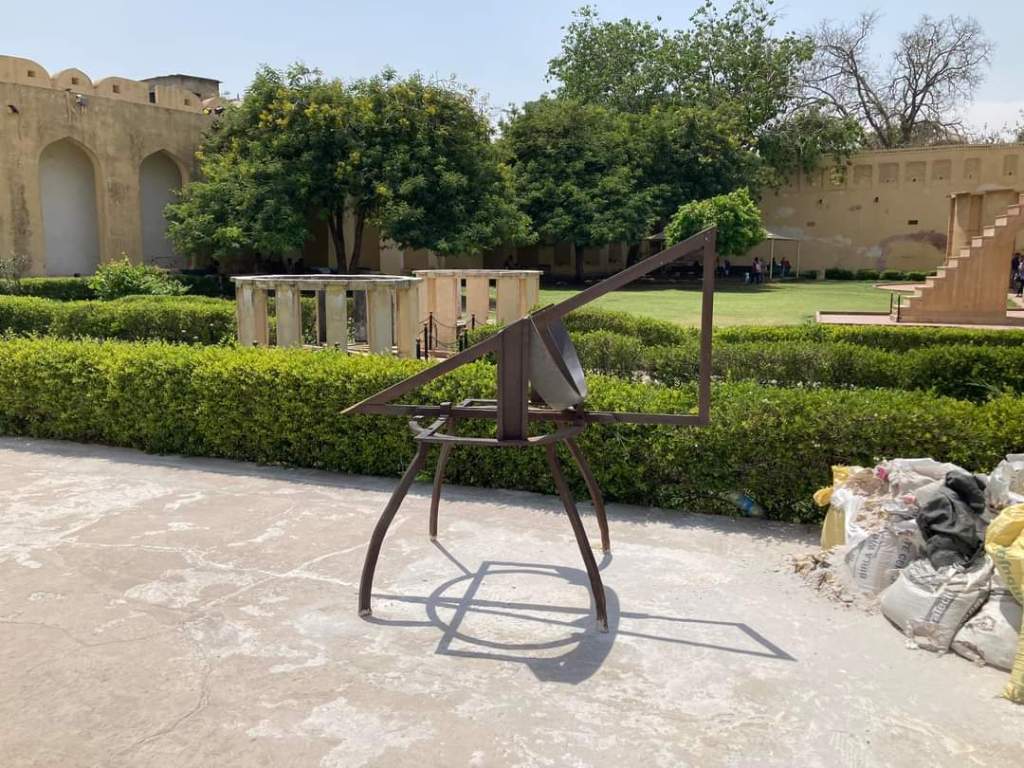
Kanali Yantra
Another Instrument in the complex that measures the azimuth of the sun.
Narivalaya Yantra – Equatorial Instrument
This has 2 circular dials facing North and South. The shadows of the rods emerging perpendicularly from the plates move along the scales on the dial plates, indicating the local time. These were also used for indicating the hemispherical position of heavenly bodies.
The one facing south, would tell the time from 21st of September to 21st of March. The other dial facing north, would tell the time for the remainder of the year. However on equinox these instrument won’t give a reading, hence one more sundial is placed on top of this structure that gives time only twice the year, i.e. when the sun is on the equatorial plane (equinox).



Shastansh Yantra
A unique 60-degree arc instrument built in the meridian plane with a slightly dark chamber. It illuminates at noon every day, with the light passing through a pinhole in the chamber and thus helps in calculating the diameter of the sun, declination and distance.

Palbha Yantra
It is a Circular instrument with a rod in the center, whose shadow on the walls determine the angle of the sun.
Misra Yantra
It’s a combination of 5 different instruments, that can be used to calculate the shortest and longest day of the year, accurate time down to fractions of seconds, declining angles of other celestial bodies, and even their altitude from Earth.
Yantra Raj Yantra

These are 2.5 metre bronze astrolabe, one of the largest in the world, used only once a year, calculates the Hindu calendar.
Krantivritta Yantra
A metal instrument consisting of two circles, the size of a car wheel, which rotates on a masonry base. Both these circles are attached at an angle, such that, one wheel represents the equatorial plane and the other the elliptical plane of earth. It is used for measuring celestial latitude and longitude.

Chakra Yantra

The chakra yantra, Jantar Mantar, Jaipur is a ring instrument which calculates the co-ordinates and the hour angle of Sun. It consists of four semi-circular arcs, on which the gnomon throws a shadow, hence deducing the declination of the Sun four times in a day.
Rama Yantra

Rama Yantra measures zenith distance and altitude of Sun and planets.
The instrument comprises a pair of cylindrical structures, open to the sky. Each structure has a pole of equal height at the center. Scales indicating angles of altitude and azimuth of extra-terrestrial bodies are inscribed inside the walls of these structures.
Unnatansha Yantra
It is used to determine the altitude of the stars and planets. This is located in the north-eastern corner of the observatory.

Dakshinottara Bhitti Yantra
This is a vertical instrument built in the plane of the local meridian mainly used for observing the different altitudes of the heavenly bodies.

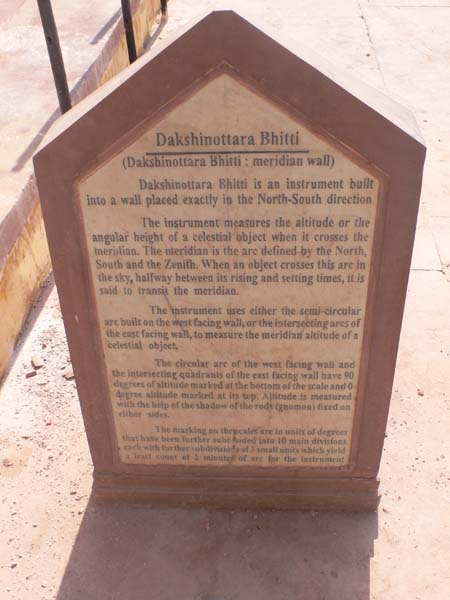
Digamsha Yantra
This simple instrument is used to figure out direction based on the shadow the sun casts. It is used to calculate the time of sunrise and sunset.
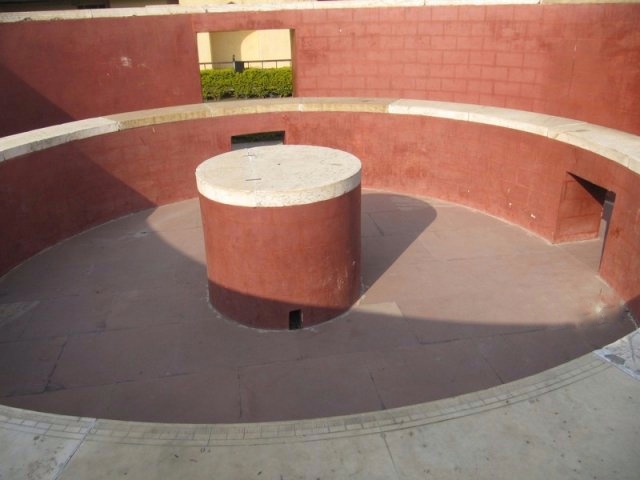
Kapali Yantra
A huge depressed hemispherical disc, covered with marble, is what the Kapali Yantra looks like. There are multiple markings in this white marble that is used to measure coordinates of celestial bodies.


Taking a reading off this instrument however was not very easy as one has to stand on the edge of the hemisphere and observe the reading on the scale, which was pretty far. In order to overcome this issue, Sawai Jai Singh designed a new instrument that split this hemisphere in two parts, and placed pathways in between to easily get closer to the scales. This instrument came to be known as Jai Prakash Yantra.
Jai Prakash Yantra
The working principle of the Kapali yantra and Jai Prakash yantra is same, it is just that this instrument had provision to get closer to the scale and hence taking the reading off it was much easier. The hemisphere surfaces are of marble and are inscribed with celestial latitude and longitude lines. From the location of the shadow cast by the sun, the astronomers could know the exact zodiac month.

Jantar Mantar, Jaipur: Timings and Location
Timings: Open on all days 9 AM to 5 PM.
Jantar Mantar Sound & Light Show
Shows are conducted in two languages: English show followed by Hindi. The timings depend on the seasons.
- October to February- 6:30 pm onwards
- March to April- 7 pm onwards
- May to September- 7:30 pm onwards
This sound & light show of 45 minutes is a tribute to Raja Sawai Jai Singh II, who personally looked into making and functioning of these astronomy instruments. The stories describe the making of Jantar Mantar and why Raja Jai Singh shifted the Kachwaha capital from Amber to the new capital city of Jaipur. There is interesting narrations about the different instruments with amazing graphics and soul stirring music.
In conclusion
The fact that Jantar Mantar remains relevant and produces accurate results to this day is fascinating, and is a proof of the craftsmanship of the generation that built it. The sheer thought and precision with which it was designed, is truly praise worthy.

